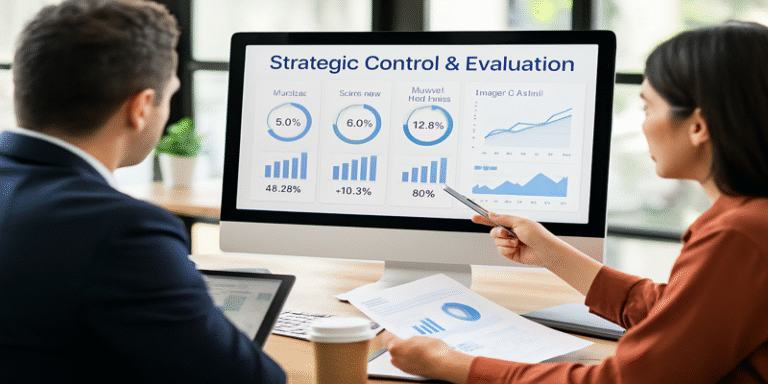Strategic control and evaluation are vital components of the strategic management process. Once a strategy has been formulated and implemented, organisations must ensure that it remains aligned with their objectives, competitive environment, and resource base (Hitt et al., 2021). Without effective control and evaluation mechanisms, even the most carefully formulated strategies may fail due to poor execution or lack of adaptation to changing circumstances. This article explores the significance of strategic control and evaluation, the role of Key Performance Indicators (KPIs), the application of the Balanced Scorecard (BSC), and the challenges of maintaining alignment between strategy and organisational performance.
The Role of Strategic Control
Strategic control refers to the process of monitoring the execution of strategies, assessing their outcomes, and making necessary adjustments (Wheelen & Hunger, 2020). Unlike operational control, which focuses on day-to-day efficiency, strategic control evaluates whether the overall strategy is effective in achieving long-term goals. According to Rothaermel (2020), the central purpose of strategic control is to ensure that strategy execution remains consistent with the organisation’s mission, vision, and competitive positioning.
For example, in the airline industry, companies such as Ryanair constantly monitor fuel costs, regulatory changes, and customer satisfaction. If their cost leadership strategy is threatened by rising operational expenses, they may implement new efficiency measures or renegotiate supplier contracts to maintain their competitive edge. This illustrates how strategic control ensures that strategy adapts to environmental shifts.
Key Performance Indicators (KPIs)
One of the most commonly used tools in strategic evaluation is the establishment of Key Performance Indicators (KPIs). KPIs are quantifiable metrics that allow managers to measure progress toward objectives (Czerwińska & Pacana, 2024). Effective KPIs must be aligned with organisational strategy, measurable, and actionable.
For instance, in a retail organisation, KPIs might include:
- Sales growth percentage (financial performance),
- Customer retention rate (customer satisfaction),
- Inventory turnover ratio (operational efficiency), and
- Employee engagement scores (organisational culture).
KPIs not only provide insights into whether strategic goals are being achieved but also signal when corrective actions are necessary. However, as Chobitok and Verkush (2025) argue, KPIs must be carefully designed to avoid an overemphasis on short-term metrics that neglect long-term strategic objectives.
The Balanced Scorecard
Developed by Kaplan and Norton (1996), the Balanced Scorecard (BSC) remains one of the most influential frameworks for strategic evaluation. Unlike traditional financial metrics, the BSC expands the focus to include four perspectives:
- Financial perspective – assessing profitability, revenue growth, and cost management.
- Customer perspective – measuring satisfaction, retention, and brand loyalty.
- Internal processes perspective – evaluating innovation, production efficiency, and quality control.
- Learning and growth perspective – examining employee skills, organisational culture, and knowledge management.
By incorporating these dimensions, the BSC ensures that organisations do not focus solely on financial outcomes but also on the drivers of long-term success (Vieira, 2025). For example, Apple uses a BSC approach by tracking not only sales of its devices but also customer satisfaction, employee innovation, and supply chain efficiency, ensuring its strategies remain sustainable.
Strategic Evaluation Process
Strategic evaluation generally follows a structured process (Johnson et al., 2017):
- Defining performance standards – identifying measurable targets based on strategic objectives.
- Measuring actual performance – collecting data through KPIs, surveys, and market analysis.
- Comparing results with objectives – evaluating deviations from expected performance.
- Taking corrective action – adjusting resources, revising strategy, or re-aligning objectives.
An example can be seen in Tesla, which sets ambitious goals around innovation and market penetration. By comparing its actual sales and production volumes against strategic objectives, Tesla evaluates whether it is on track to achieve its vision of accelerating sustainable energy adoption. Deviations, such as supply chain disruptions, are addressed through corrective actions like investing in in-house battery production.
Challenges in Strategic Control
While strategic control is essential, organisations face several challenges:
- Information overload: Managers may be overwhelmed by excessive data, making it difficult to focus on critical indicators (Melikidze, 2025).
- Resistance to change: Employees may resist corrective actions if they perceive them as threats to existing routines.
- Short-termism: Overemphasis on quarterly financial KPIs may undermine long-term strategic objectives (Wakeanda & Obere, 2025).
- External uncertainty: Rapid environmental changes, such as economic downturns or technological disruptions, can render existing strategies obsolete.
For example, during the COVID-19 pandemic, many firms discovered that their existing KPIs and evaluation frameworks were no longer adequate. Hospitality businesses had to adopt new measures focused on digital engagement and health safety rather than traditional occupancy rates.
The Importance of Feedback and Learning
Strategic control should not only be about monitoring but also about organisational learning. According to Argyris (1999), effective organisations engage in double-loop learning, where they do not only correct deviations from plans but also question whether the underlying assumptions of the strategy are still valid.
For instance, Netflix initially focused on DVD rentals. Through continuous evaluation and learning, it recognised the shift towards streaming services, adjusting its business model accordingly. Today, its KPIs focus on subscriber growth, viewing hours, and content quality – all aligned with its evolving strategy.
Integrating Technology in Strategic Evaluation
The use of Business Intelligence (BI) systems and data analytics has transformed strategic control. Modern systems allow for real-time monitoring of KPIs, predictive analytics, and data visualisation dashboards (Chobitok & Verkush, 2025).
For example, Amazon employs advanced analytics to evaluate customer behaviour, supply chain efficiency, and new product launches. By integrating AI-driven insights, it can adapt its strategy faster than competitors. Similarly, banks use the BSC integrated with digital dashboards to evaluate risk management, compliance, and customer satisfaction (Melikidze, 2025).
Strategic control and evaluation are indispensable for ensuring that organisations remain aligned with their long-term objectives. Tools such as KPIs and the Balanced Scorecard provide structured frameworks to measure progress, identify deviations, and adapt to environmental changes. However, organisations must avoid pitfalls such as information overload, short-termism, and resistance to change.
The future of strategic evaluation lies in leveraging technology, embracing organisational learning, and integrating financial and non-financial performance measures. By doing so, organisations can ensure that their strategies remain relevant, flexible, and effective in achieving sustainable success.
References
Argyris, C. (1999) On Organisational Learning. 2nd ed. Oxford: Blackwell.
Chobitok, V. and Verkush, D. (2025) ‘Scientific and methodological framework for evaluating intellectual and strategic management of innovativeness in business entities’, Scientific Notes, 39(2). Available at: https://vz.kneu.ua/archive/2025/39(2).21.
Czerwińska, K. and Pacana, A. (2024) ‘Improving strategic management in the foundry industry using KPI’, Management & Business, 12(3), pp. 45–59.
Hitt, M.A., Ireland, R.D. and Hoskisson, R.E. (2021) Strategic Management: Competitiveness and Globalisation. 14th ed. Boston: Cengage.
Johnson, G., Scholes, K. and Whittington, R. (2017) Exploring Strategy: Text and Cases. 11th ed. Harlow: Pearson.
Kaplan, R.S. and Norton, D.P. (1996) The Balanced Scorecard: Translating Strategy into Action. Boston: Harvard Business School Press.
Melikidze, N. (2025) ‘Estimation of effectiveness of modern information systems and technologies in banks by Balanced Scorecard (BSC) method’, Georgian Scientists, 15(1), pp. 101–119.
Rothaermel, F.T. (2020) Strategic Management. 5th ed. New York: McGraw-Hill.
Wakeanda, R.W. and Obere, E. (2025) ‘Strategic management practices and performance of technology start-up companies in Nairobi City County, Kenya’, Journal of Strategic Management, 9(2), pp. 88–103.
Wheelen, T.L. and Hunger, J.D. (2020) Strategic Management and Business Policy: Globalisation, Innovation, and Sustainability. 16th ed. Harlow: Pearson.
Vieira, J.K.R. (2025) Proposta de Planejamento Estratégico com aplicação do Balanced Scorecard: estudo de caso em uma construtora. PhD Thesis. Universidade Federal do Amazonas.









